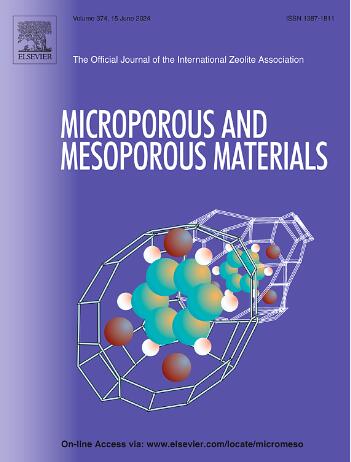Poisoning effect of chlorine anions in the catalytic activity of CuO/CeO2/UiO-66 for CO-PROX reaction and strategy for catalyst activation
IF 4.8
3区 材料科学
Q1 CHEMISTRY, APPLIED
引用次数: 0
Abstract
UiO-66 was synthesized using ZrOCl2·8H2O as metal precursor, and CuO/CeO2/UiO-66 catalysts were prepared and tested for preferential CO oxidation in H2-rich streams (CO-PROX reaction), a reaction of practical significance in hydrogen purification for fuel cells. The study highlights the detrimental effect of residual chlorine anions from UiO-66 synthesis and DMF washing on the catalytic performance of CuO/CeO2/UiO-66. An activation strategy involving rigorous water washing and thermal treatment at 160 °C under CO-PROX conditions was developed. Both steps were deemed necessary, as employing only one proved insufficient to reduce chlorine levels to non-poisoning thresholds. This activation procedure does compromise UiO-66 crystallinity and porosity, but it is justified by achieving a fully functional catalyst. TEM images confirm the uniform dispersion of the CuO/CeO2 active phase on the UiO-66 matrix post-activation and after catalytic testing. A 16-h CO-PROX test at 160 °C with the CuO/CeO2/UiO-66 catalyst, once activated, demonstrated stable performance throughout the extended long-term experiment. This research provides valuable insights into optimizing CuO/CeO2/UiO-66 catalysts for CO-PROX application.

求助全文
约1分钟内获得全文
求助全文
来源期刊

Microporous and Mesoporous Materials
化学-材料科学:综合
CiteScore
10.70
自引率
5.80%
发文量
649
审稿时长
26 days
期刊介绍:
Microporous and Mesoporous Materials covers novel and significant aspects of porous solids classified as either microporous (pore size up to 2 nm) or mesoporous (pore size 2 to 50 nm). The porosity should have a specific impact on the material properties or application. Typical examples are zeolites and zeolite-like materials, pillared materials, clathrasils and clathrates, carbon molecular sieves, ordered mesoporous materials, organic/inorganic porous hybrid materials, or porous metal oxides. Both natural and synthetic porous materials are within the scope of the journal.
Topics which are particularly of interest include:
All aspects of natural microporous and mesoporous solids
The synthesis of crystalline or amorphous porous materials
The physico-chemical characterization of microporous and mesoporous solids, especially spectroscopic and microscopic
The modification of microporous and mesoporous solids, for example by ion exchange or solid-state reactions
All topics related to diffusion of mobile species in the pores of microporous and mesoporous materials
Adsorption (and other separation techniques) using microporous or mesoporous adsorbents
Catalysis by microporous and mesoporous materials
Host/guest interactions
Theoretical chemistry and modelling of host/guest interactions
All topics related to the application of microporous and mesoporous materials in industrial catalysis, separation technology, environmental protection, electrochemistry, membranes, sensors, optical devices, etc.
 求助内容:
求助内容: 应助结果提醒方式:
应助结果提醒方式:


